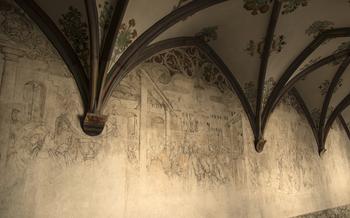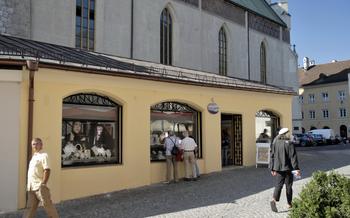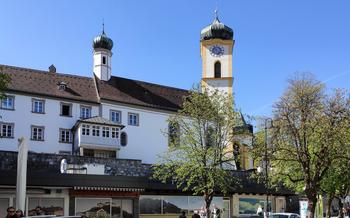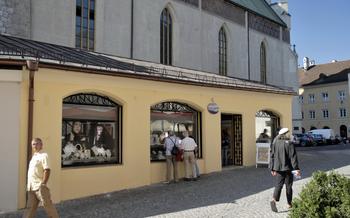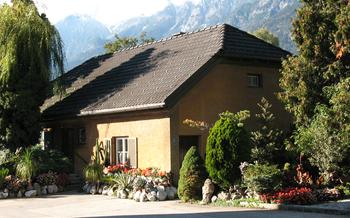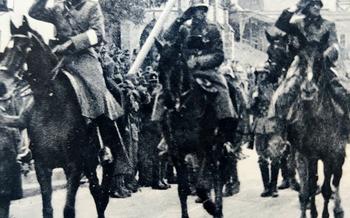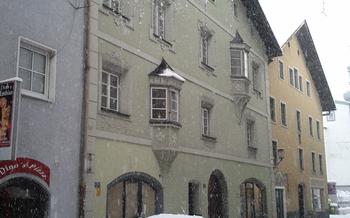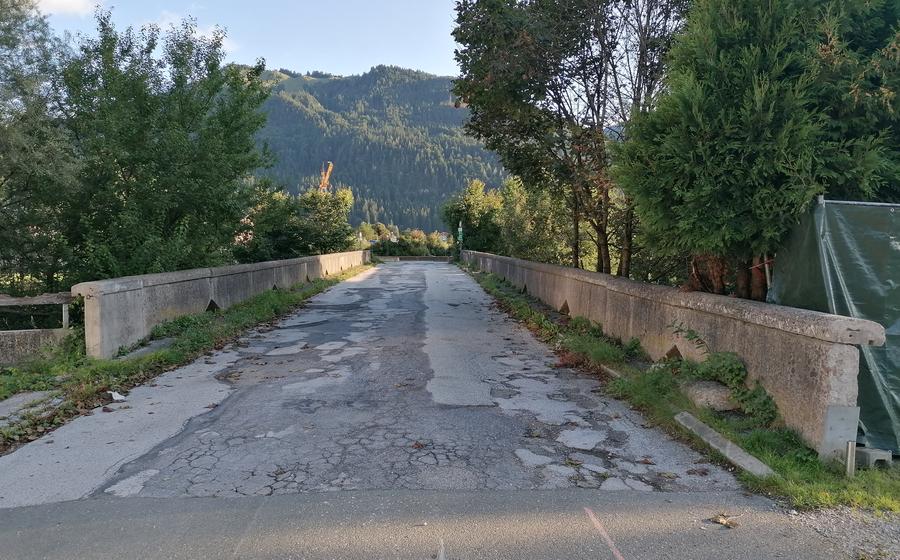
Kufstein Fortress
- The Kufstein Fortress: Atop the Inn Valley
- Reaching the Fortress
- Exploring the Fortress
- The Heroes' Organ
- The Emperor's Tower
- The Deep Well: A Mysterious Abyss
- The Prison Tower: A Glimpse into Medieval Confinement
- The Blacksmith's Shop
- The Armoury: A Glimpse into Medieval Warfare
- The Chapel
- The Museum
- The Shop
- Events at the Fortress
- Insider Tip: The Best Time to Visit
The Kufstein Fortress: Atop the Inn Valley
The Kufstein Fortress, a majestic symbol of Tyrolean history and resilience, stands atop a rocky outcrop overlooking the Inn Valley. Its imposing presence has guarded the region for over 800 years. Originally built in the 13th century, the fortress has witnessed countless battles, sieges, and transformations throughout the centuries. Today, it remains one of Austria's most well-preserved and iconic landmarks, inviting visitors to delve into its rich past and immerse themselves in the captivating stories it holds.
History
The origins of the Kufstein Fortress can be traced back to the 12th century when the Counts of Andechs erected a fortified tower on the site to protect their strategic trade route along the Inn River. Over the following centuries, the fortress was expanded and strengthened, becoming a crucial defensive outpost for the Tyrolean rulers. In 1504, Emperor Maximilian I significantly enlarged the fortress, transforming it into a formidable stronghold capable of withstanding enemy attacks.
Architecture
The Kufstein Fortress is a testament to medieval military engineering. Its impressive fortifications include a series of walls, towers, and bastions that were designed to repel invaders. The fortress's unique architecture reflects the influence of various historical periods, from the Romanesque foundations to the Gothic and Renaissance additions. Visitors can admire the intricate stonework, vaulted ceilings, and grand staircases that adorn the fortress's interior.
Legends
The Kufstein Fortress is steeped in legends and folklore. One of the most famous tales is the story of the "Kufsteiner Riesen," or the Kufstein Giants. According to the legend, two giants named Haymon and Thyrsus were tasked with building the fortress. However, they were tricked by a cunning farmer who convinced them to carry out impossible tasks, ultimately leading to their demise.
Views
The Kufstein Fortress offers breathtaking panoramic views of the surrounding landscape. From its ramparts and towers, visitors can gaze out over the Inn Valley, the Tyrolean Alps, and the picturesque town of Kufstein nestled below. The fortress's elevated position provides a unique perspective, allowing visitors to appreciate the region's natural beauty and historical significance.
Reaching the Fortress
The journey to the Kufstein Fortress is as captivating as the destination itself. Hikers can embark on a scenic 15-minute uphill walk through the lush greenery of the Festungspark, relishing panoramic views of the Inn Valley. Along the way, they'll encounter the Heroes' Monument, a poignant tribute to Tyrolean freedom fighters.
For those seeking a more leisurely ascent, the Kufstein Fortress Cable Car offers a breathtaking 5-minute ride to the summit. The cable car glides over the treetops, providing unparalleled vistas of the surrounding Tyrolean landscape.
Alternatively, visitors can drive to the fortress, taking advantage of the ample parking spaces available on-site. This option is particularly convenient for those with limited mobility or traveling with young children.
Exploring the Fortress
The Kufstein Fortress offers a range of captivating experiences for visitors, allowing them to delve into its rich history, marvel at its architectural wonders, and uncover its hidden secrets. Embark on a guided tour to gain insights into the fortress's past, its role in defending the Inn Valley, and the intriguing tales that have unfolded within its walls. Alternatively, explore the fortress at your own pace with a self-guided tour, allowing you to wander through its chambers, courtyards, and towers, discovering hidden nooks and crannies along the way.
Immerse yourself in the captivating exhibits that showcase the fortress's fascinating history, from its origins as a medieval stronghold to its transformation into a state-of-the-art military fortification. Don't miss the medieval workshop, where skilled artisans demonstrate traditional crafts and techniques, providing a glimpse into the daily life of the fortress's inhabitants centuries ago.
The Heroes' Organ
The Heroes' Organ is undoubtedly one of the most iconic landmarks of the Kufstein Fortress. This magnificent organ was built in 1931 by the renowned organ builder Rieger Orgelbau to commemorate the Tyrolean soldiers who lost their lives during World War I. The organ is housed in a specially designed chamber within the fortress walls, and its majestic sound can be heard throughout the Inn Valley.
The Heroes' Organ consists of over 4,000 pipes, ranging in size from a few centimeters to over 10 meters in length. It is played by a single organist, who sits at a console located in the center of the chamber. The organ's repertoire includes a wide variety of classical and contemporary music, as well as traditional Tyrolean folk songs.
Daily Performances
One of the highlights of a visit to the Kufstein Fortress is the opportunity to hear a performance on the Heroes' Organ. Daily concerts are held throughout the year, and visitors can choose from a variety of different programs. The concerts typically last for about 30 minutes, and they are a wonderful way to experience the unique sound of this historic instrument.
Design
The Heroes' Organ is not only a musical masterpiece, but it is also a work of art. The organ case is made of carved wood, and it is decorated with intricate carvings and paintings. The organ pipes are made of a variety of materials, including wood, metal, and glass. The overall effect is one of grandeur and opulence, and the organ is a fitting tribute to the brave Tyroleans who lost their lives in World War I.
The Emperor's Tower
The Emperor's Tower, also known as the Keep, is the most prominent and iconic structure within the Kufstein Fortress. It was erected in the 13th century as a symbol of power and authority, and served as the residence of the fortress's commander.
The tower boasts an impressive height of 54 meters, offering breathtaking panoramic views of the Inn Valley and the surrounding Tyrolean Alps. Its imposing presence has made it a popular landmark and a must-visit attraction for tourists exploring the fortress.
The Emperor's Tower's architectural design showcases a blend of Romanesque and Gothic elements. Its thick, sturdy walls and narrow windows reflect its defensive purpose, while the decorative details hint at its significance as a symbol of power. Visitors can climb the tower's winding staircase to reach the viewing platform at the top, where they are rewarded with unparalleled vistas of the Tyrolean countryside.
Within the tower lies a hidden gem – the dungeon. This dark and eerie chamber was once used to imprison and torture prisoners. Visitors can explore the dungeon and learn about the harsh conditions endured by those who were unfortunate enough to be held captive within its walls.
The Emperor's Tower is a testament to the Kufstein Fortress's rich history and its role as a strategic stronghold. Its commanding presence and stunning views make it a highlight of any visit to the fortress, offering a glimpse into the lives of those who once resided within its walls.
The Deep Well: A Mysterious Abyss
The Deep Well, also known as the Kaiserbrunnen, is one of the most intriguing features of Kufstein Fortress. This ancient well is steeped in mystery and legend, capturing the imagination of visitors for centuries.
History and Legend
The Deep Well was dug in the 13th century to provide a reliable water source for the fortress. Legend has it that the well was dug by prisoners, who were promised their freedom if they reached a certain depth. However, as the prisoners dug deeper and deeper, the water level continued to rise, thwarting their efforts to reach the surface.
Depth and Executions
The Deep Well is an impressive feat of engineering, reaching a depth of over 60 meters. It is said that the well was used as a place of execution during the Middle Ages. Condemned prisoners would be thrown into the well, either to drown or to be crushed by the falling rocks.
Exploring the Well
Today, the Deep Well is open to visitors as part of the Kufstein Fortress tour. Visitors can peer into the well's dark depths and imagine the stories that lie hidden within. The well is a reminder of the harsh reality of life in medieval times, when survival was a daily struggle.
The Prison Tower: A Glimpse into Medieval Confinement
The Prison Tower, also known as the Keep, stands as a testament to the fortress's former role as a prison. Its dark and narrow interior, illuminated only by a few small windows, provides a glimpse into the harsh conditions faced by prisoners in the Middle Ages.
The tower has three levels, each of which was used to hold different types of prisoners. The upper level housed political prisoners and those accused of serious crimes. The middle level was reserved for debtors and petty criminals, while the lower level served as a dungeon for the most dangerous and unruly inmates.
The conditions in the prison were harsh and unsanitary. Prisoners were often shackled and left to rot in their cells, with little food or water. Many died from disease, malnutrition, or suicide.
The walls of the Prison Tower are covered in graffiti, which provides a unique glimpse into the lives of the prisoners. The graffiti includes drawings, inscriptions, and even poems, all of which speak to the suffering and despair of those who were incarcerated within these walls.
One of the most famous prisoners to be held in the Prison Tower was Andreas Hofer, a Tyrolean rebel leader who was executed by firing squad in 18Hofer's cell is still preserved today, and it is a popular tourist attraction.
The Prison Tower is a reminder of the harsh realities of medieval life. It is a place where visitors can learn about the history of crime and punishment, as well as the suffering of those who were incarcerated within its walls.
The Blacksmith's Shop
The blacksmith's shop within the Kufstein Fortress is a fascinating glimpse into the past. This centuries-old space was once a bustling hub of activity, where skilled artisans forged tools, weapons, and other essential items for the fortress and the surrounding community.
The shop's interior is a testament to the blacksmith's craft. An impressive array of tools hangs from the walls, including hammers, anvils, tongs, and bellows. The air still seems to carry the echoes of the blacksmith's rhythmic hammering and the glow of the forge fire.
During the summer months, visitors can witness live demonstrations by skilled blacksmiths who bring the shop to life. They use traditional techniques to forge various items, from simple nails to intricate works of art. It's a captivating experience that allows visitors to appreciate the skill and dedication required in this ancient craft.
The blacksmith's shop also doubles as a souvenir shop, where visitors can purchase unique handcrafted items made by local artisans. These one-of-a-kind pieces, ranging from knives and jewelry to decorative items, make for memorable keepsakes that capture the essence of the Kufstein Fortress.
The Armoury: A Glimpse into Medieval Warfare
The Armoury at Kufstein Fortress is a treasure trove of medieval weaponry, providing a fascinating glimpse into the art of warfare during the Middle Ages. The collection boasts an impressive array of swords, spears, crossbows, helmets, and suits of armour, each meticulously crafted and adorned with intricate designs.
Visitors can marvel at the sheer size and weight of the armour, a testament to the physical strength and endurance required by medieval knights. The intricate details and craftsmanship on the helmets and breastplates showcase the artistry and skill of the armourers. The collection also includes a variety of weapons, from simple daggers to massive two-handed swords, offering insights into the diverse combat techniques of the era.
Displays within the armoury provide detailed information about the different types of weapons and armour, their historical significance, and their use in battle. Visitors can learn about the evolution of armour and weaponry over time, from the chain mail of the early Middle Ages to the plate armour of the late medieval period.
The armoury also houses a collection of historical documents, including manuscripts and chronicles, that shed light on the military history of Kufstein Fortress and the surrounding region. These documents provide valuable insights into the strategies, tactics, and weaponry used by the defenders of the fortress throughout the centuries.
Overall, the Armoury at Kufstein Fortress offers a captivating journey into the world of medieval warfare, showcasing the tools and techniques used by knights and soldiers to defend their lands and protect their way of life.
The Chapel
The chapel, a testament to the spiritual devotion of the fortress's inhabitants, finds its home within the confines of the fortress, its presence a poignant reminder of the solace sought amidst the trials and tribulations of medieval life. Constructed in the 16th century, its interior is a testament to the artistic and religious sensibilities of the era.
The walls are adorned with intricate frescoes, their vibrant hues depicting scenes from the Bible and the lives of the saints, each stroke a testament to the skill and devotion of the artists who brought them to life. The stained glass windows, with their kaleidoscope of colors, cast an ethereal glow upon the interior, transforming the space into a sanctuary of light and reflection.
The altar, a masterpiece of craftsmanship, takes center stage, its intricate carvings narrating tales of faith and devotion. The pulpit, a testament to the power of the spoken word, stands as a silent witness to the sermons and prayers that have echoed within these hallowed walls.
The chapel, with its serene and contemplative atmosphere, invites visitors to pause and reflect upon the spiritual heritage that permeates the fortress, a reminder that even in the midst of turmoil and strife, the human spirit yearns for connection with the divine.
The Museum
The Kufstein Fortress proudly houses a captivating museum that delves into the rich history of the fortress and the surrounding region. Established in 1924, the museum is a treasure trove of artefacts, exhibits and interactive displays that bring the past to life.
One of the highlights of the museum is the "Kufstein Fortress Through the Ages" exhibit, which takes visitors on a chronological journey through the various eras of the fortress's existence. From its humble beginnings as a simple watchtower to its transformation into a formidable fortress and, ultimately, its current status as a beloved cultural landmark, this exhibit offers a comprehensive overview of the fortress's storied past.
In addition to its historical focus, the museum also showcases exhibits dedicated to local culture, traditions, and craftsmanship. Visitors can admire intricate Tyrolean wood carvings, learn about the region's rich musical heritage, and even witness demonstrations of traditional Tyrolean crafts, such as blacksmithing and weaving.
The museum's collection also includes an impressive array of artefacts, including medieval weapons and armour, domestic utensils, and everyday objects that provide a glimpse into the daily lives of the people who lived and worked within the fortress walls.
Whether you're a history buff, a culture enthusiast, or simply curious to learn more about the Kufstein Fortress, the museum is an essential stop on your visit. Its engaging exhibits and informative displays offer a deeper understanding of this iconic landmark and its profound impact on the region's history and culture.
The Shop
Located conveniently within the fortress walls, the shop at Kufstein Fortress offers a delightful array of souvenirs and keepsakes to commemorate your visit. Browse through an eclectic collection of items inspired by the fortress's rich history and local Tyrolean culture.
Unique Souvenirs:
Discover a treasure trove of unique and locally crafted souvenirs, perfect for preserving cherished memories of your time at the fortress. From hand-painted postcards and postcards and magnets featuring stunning fortress views to intricately carved wooden figurines and traditional Tyrolean handicrafts, the shop offers a diverse range of mementos to suit every taste.
Books and Publications:
For those seeking a deeper dive into the fortress's history, the shop offers an array of informative books and publications. Explore comprehensive guidebooks, historical accounts, and captivating illustrated volumes that provide a wealth of knowledge about the fortress's past and its significance in the region.
Convenient Location:
Strategically positioned within the fortress, the shop is easily accessible to visitors as they explore the various attractions and exhibits. Whether you're seeking a unique souvenir or simply want to browse the fascinating collection, the shop provides a convenient and enjoyable shopping experience.
Events at the Fortress
The Kufstein Fortress is not just a historical monument but also a vibrant cultural hub. Throughout the year, the fortress hosts a variety of events that attract both locals and tourists alike. One of the highlights is the annual Kufstein Fortress Concerts, a series of classical music concerts held in the atmospheric courtyard of the fortress. The concerts feature renowned orchestras and soloists from around the world, and the stunning backdrop of the fortress creates a truly unforgettable experience.
In addition to the concerts, the fortress also hosts a number of other events, including festivals, exhibitions, and markets. The Kufstein Fortress Festival, held every summer, features a variety of performances, from theater and dance to music and comedy. The Kufstein Christmas Market, held in December, is a magical event that transforms the fortress into a winter wonderland, complete with stalls selling traditional Tyrolean crafts, mulled wine, and gingerbread.
If you're visiting the Kufstein Fortress, be sure to check the event calendar to see what's on during your stay. Whether you're interested in classical music, theater, or simply soaking up the festive atmosphere, there's sure to be an event that you'll enjoy.
Insider Tip: The Best Time to Visit
To fully appreciate the grandeur of Kufstein Fortress, plan your visit strategically. Avoid the midday rush by arriving early or late in the day to wander through its chambers without jostling crowds. If photography is your passion, capture the fortress's majesty during the golden hours of dawn and dusk, when the warm light casts a magical glow on its ancient walls.
Weather-wise, spring and autumn offer pleasant temperatures, making your exploration more enjoyable. Winter transforms the fortress into a snowy wonderland, providing a unique perspective but requiring appropriate clothing. During summer, the fortress buzzes with activity, so embrace the lively atmosphere and immerse yourself in the vibrant events and festivals that bring history to life.
Finally, check the fortress calendar for special events that may coincide with your visit. From medieval markets to concerts and exhibitions, these occasions offer a deeper dive into the fortress's rich history and culture, making your experience truly unforgettable.
